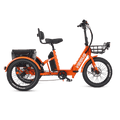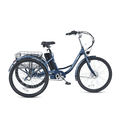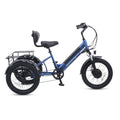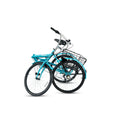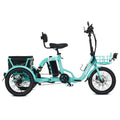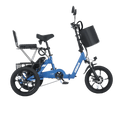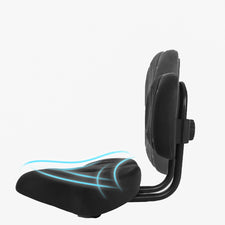Ebike FAQ Frequently Asked Question
Welcome to the Viribus frequently asked questions page! Below we have provided answers to our most commonly asked customer questions about our bikes, ebikes, tricycles, parts, and more. If you cannot find the answer you need here, please don't hesitate to contact us directly.
Before You Buy
General
How do I choose the right bike size?
Refer to our handy size guide chart to determine which frame size is ideal based on your height. Getting the proper fit is crucial for comfort and control. Our team can also provide fitting recommendations if you contact us with your measurements.
What is the difference between men's and women's bikes?
The main differences are the frame size/geometry and saddle design. Women's bikes have a shorter top tube and lower standover height. The saddles are wider and designed to accommodate hip width. Handlebars may also be narrower. Choose a women's model if you prefer these accommodations.
What type of bike is best for recreational riding?
For casual riding on paved surfaces like roads, paths and trails, we recommend a comfortable hybrid or cruiser bike. These have an upright riding position and medium width tires. Ebikes are also great for recreational use.
What is your return and exchange policy?
We offer a 30-day return window for refunds or exchanges on unused products. Contact us within 30 days to initiate a return. We unfortunately cannot accept returns of assembled bikes. Read our full policy on our website before ordering.
Ebikes
How far can I ride on one e-bike charge?
Our ebike batteries typically last for 30–50 miles depending on terrain, rider weight, speed, and pedal assist level used. For maximum range, use lower assist modes and pedal more yourself. Charge after every ride to prolong battery life.
What is the top speed for your e-bikes?
Our ebikes can reach speeds of 15-24 mph depending on the model and assist mode. Class 1 and 2 ebikes max out at 20mph using motor power alone. Pedaling faster is possible. Check individual specs to confirm top speeds.
Can e-bikes go up steep hills?
Absolutely! The pedal assist system provides extra power to climb inclines easily. Our mid-drive motors apply torque optimally for excellent hill traction. Just shift to a lower gear to handle steep grades comfortably.
Tricycles
What are the benefits of a tricycle over a traditional bike?
Tricycles provide increased stability and balance over two-wheeled bikes, making them ideal for seniors or those with mobility limitations. The three-wheel design also means you can stop and sit upright on the trike without tipping over.
How are adult tricycles different from children's tricycles?
Adult trikes are larger to accommodate adult riders. They utilize stronger materials, have more robust frames and wheels, include adjustable components, and often feature multi-speed drivetrains. Always choose an adult trike over a children's model.
What size adult trike should I get based on my height?
Use the following as a general height guide for our adult trikes:
4'10" to 5'2" = 13-15" compact frame
5'3" to 6'0" = 17-19" mid-size frame
Over 6' = 21-23" large frame
Can you attach accessories like baskets, bells, flags etc to your trikes?
Absolutely! Our trikes have numerous attachment points to add accessories like rear baskets, safety flags, bells, bottle holders and more. We even sell many add-on accessories. Just contact us if you need help picking compatible options.
How durable and longlasting are the trike tires?
Our trike tires are designed for rugged durability and stability. They have puncture-resistant Kevlar lining and sturdy tread. With proper inflation and avoidance of curbs, they typically last several years under regular recreational use before needing replacement.
What is the turning radius of your adult trikes?
Our standard 20” wheel trikes have a turning radius of 8.5 feet. The 16” wheel models can turn in an even tighter 5 foot radius. This makes the trikes very maneuverable through tight spaces and corners.
Are trikes okay to ride while pregnant?
Absolutely! The upright seating and added stability of a trike make them a great cycling option during pregnancy. Just ensure you get a properly sized frame with enough standover height to accommodate your changing body. Many women find trikes more comfortable than standard bikes when expecting.
After You Buy
Assembly Guides
Please refer to the included printed manual for step-by-step assembly instructions specific to your particular Viribus bike, ebike or trike model. Our guides provide details on attaching the key components like the handlebars, seat, pedals, wheels and inflating the tires. Contact us if you have any assembly questions!
Battery Usage
How do I charge an e-bike battery? How long does it take?
Plug the included charger into the charging port on the battery. When the light on the charger turns green, the battery is fully charged after about 4-6 hours. Charging times vary based on the battery capacity. Avoid leaving it charging for more than 24 hrs.
Can e-bike batteries be removed for charging?
Yes, our ebike batteries can be conveniently removed from the frame for charging by unlocking the battery lock. This allows you to charge them indoors or protect them from elements when not riding.
What is the lifespan of your e-bike batteries?
With regular use and proper care, our lithium-ion batteries last for approximately 500 full charges. Don't let it drain completely, store charged between 40-80%, and avoid excessive heat exposure to maximize lifespan. The batteries can be replaced once depleted.
What happens if my e-bike battery dies mid-ride?
You can still pedal the ebike normally like a regular bike if the battery dies. However, you will lose the electric pedal assist. Best practice is to monitor battery level and recharge before it’s fully depleted to avoid being stranded. We recommend carrying a backup charging pack.
Can I upgrade my existing bike to an e-bike?
In most cases, yes! We sell high-quality conversion kits that allow you to electrify a standard pedal bike. Our knowledgeable staff can recommend the appropriate kit and components like motors and batteries to work with your specific bike. Contact us for recommendations.
Where/when/how long to charge the battery?
Charge your ebike battery in a cool, dry place indoors. Avoid temperature extremes. Charge after every ride or whenever the battery is below 40% capacity. Fully recharge every two months if storing long term. Leave charging up to 24 hours until the light indicates full battery.
Tires
Fat Tires
Maintenance: Inflate fat tires to the PSI range indicated on the tire sidewall. Inspect tread for cuts or wear. Uneven wear indicates misalignment. Avoid curbs and obstacles which can dent the rims. Wash with mild soap and water only.
How to Replace: New tires should be the same width and diameter as the originals. Use plastic tire levers to pry the bead over the rim. Install valve stem through rim hole and work the tire back on, ensuring it sits in the rim channels evenly. Inflate fully and check for wobbles.
Regular Tires
Maintenance: Maintain 30-65 PSI depending on tire width. Inspect tread and sidewalls periodically for damage cuts or wear. Avoid curbs. Clean gently with water and mild detergent only.
How to Replace: Match the original tire width and diameter for replacement. Use tire levers to remove one side of the tire from the rim. Replace or inspect inner tube if needed. Remount one side of tire into rim channel and work the remainder back over the rim until fully seated.
Storage
What is the best way to store my bike long-term?
Store your bike indoors on a bike rack or wall hanger if possible. Avoid outdoor sheds with temperature swings. Ensure tires are properly inflated and turn pedals periodically. Wipe off dust and dirt, lubricate the chain and apply protective wax.
How should I store my battery when not using my e-bike?
Fully charge the battery before storage. Disconnect from the ebike and store in a cool, indoor location away from heat, moisture and extreme cold. Recharge every 2 months to avoid full depletion. Never store batteries below 20% charge.
Is it ok to store my bike outside? What precautions should I take?
Outdoor bike storage is not ideal but can work if needed. Use a covered patio or invest in a bike cover to protect from rain, snow and excess sun exposure. Keep it clean and dry, lubricate well, and bring indoors during extreme weather swings.
How can I properly clean and maintain my bike while in storage?
Wipe down the frame periodically with a damp cloth to remove dust and dirt buildup. Lubricate the chain and gears every few months. Check tire pressure and inflate as needed. Recharge ebike batteries every 2 months. Perform any needed tune-ups or repairs before extended storage periods.
What is the ideal storage temperature range for bikes?
Store your bike in a controlled climate area with temperatures between 55° and 80° Fahrenheit. Avoid hot garages, sheds or attics as excess heat can damage components. Extreme cold can make tires and tubes brittle.
Bike Insurance
Is bike insurance necessary or recommended?
Bike insurance provides peace of mind against theft or damage, but is not mandatory. Consider your bike's value, where you store it, and how often you lock it up in public to determine if coverage makes sense financially. Many renters or home insurance policies include some bike coverage.
What are the benefits of insurance for my bicycle?
Bike insurance can reimburse you for the value of your bike if it is stolen or damaged. Policies cover loss from theft, accidents, natural disasters, vandalism and more. Coverage for custom parts and accessories is also usually available. Filing claims for repairs or replacement is easy.
Do you offer or recommend bike insurance?
We do not currently offer insurance directly, but suggest discussing options with your insurance agent or a dedicated cycling insurance provider. We're happy to provide your bike's full replacement value to aid in purchasing the right policy. Many home or renters insurance plans can simply be upgraded to add bike coverage too.
What does bike insurance typically cover?
Standard bicycle insurance covers theft, accidental damage from crashes or drops, natural disasters like floods or storms, vandalism, and other losses. Upgraded plans add coverage for custom parts, racing/events, travel protection and more. Policies and deductibles vary, so read details closely and inquire about any exclusions.

